Updated: 04-Dec-2023
This is the “Socièté Europèene de Propulsion”. SEP was founded on October 1, 1969 by the merger of SEPR and the Space and Missiles Division of Snecma. Today totally in Snecma/Safran.

“First SEP logo”
-On October 1, 1971, it absorbed LRBA, especially those related to propulsion systems for space launchers, sounding rockets and satellites.
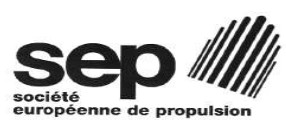
“Later logo”
-From these contributions plus their own production, they initially offered more than 60 rocket engines.
-SEP developed solid fuel, cryogenic, hybrid, fluorine and its components, compressed gas, hydrazine engines.
-Some engines would be:
-The SEP 299 “Arz” delivering 4,400 Kgf of thrust.

“SEP 299”
-The SEP 163 “Sioule”, 140 Kgf.
-The 6854 “Oder”, 3,950 Kgf.
-The SEP 738, 8,750 Kgf.
-The 739, 16,600 Kgf.
-The 7342 “Vienne”, 28,000 Kgf.
-The 300 “Drac”, 100 Kgf.

“SEP 300, Drac”
-The ELDO-Perigee, 4,000 Kgf.
-The 7342 “Yonne”, 21,130 Kgf.

“SEP Sybil” (PeT)
-The Sybil, from 1985, was for the last stage of the S4 type ballistic missile of 6,000 N using MMH (MonoMethyl-Hydrazine) and N2O4. It had a ceramic composite chamber.
-The 7392 “Rance”, 65,820 Kgf.

“844”
-The 844 series was for takeoff and combat aid of the Mirage III, that is, boosters.
NOTE: When SEP was founded in 1969, many of their engines came from SEPR. In the next chapter the rest of the engines that are still known by that name and reference will appear.
-SEP was joined by LRBA in 1971 (see). They all ended up within the Snecma group and therefore Safran.
-The engines are the same in all companies.
-We now add other products that are appearing, such as the small solid fuel ones called Apogee, the well-known Mage made in collaboration with German MAN and Italian BPD (Difesa e Spazio).
-The Mage engines have been used to place Earth meteorological observation and telecommunications satellites in geosynchronous orbit.
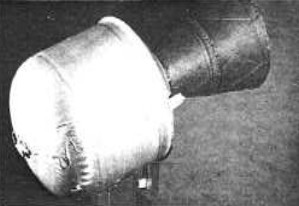
“Mage Solid Rocket Motor”
-The Mage engines deliver specific pulses of 288 to 294 seconds for a burn time of 45 seconds. Moving satellites from 800 to 1,200 Kgf to higher altitudes, such as Meteosat, Marecs, ECS, Telecom and Giotto.

“Solid SEP engine made of composite materials”
-Another apogee engine is the Mars, which we see below. Built by SEP, we see the collaboration of SNPE, Labinal, Alsthom and the Fibra & Mica company.
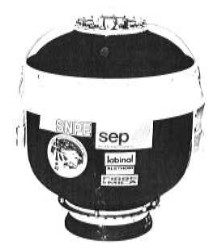
“Mars apogee solid engine”

“Two old engines at the Safran Museum”
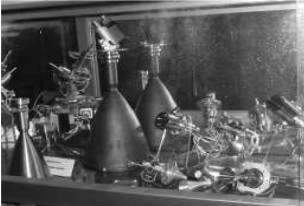
“Showcase with satellite maneuvering engines in the Safran Museum itself”

“SEP Mage”
-There are two Mage versions, I and II. The one in the figure delivers 6,835 lbf. It is a solid apogee rocket motor. One unit is on display in the Cité de l'Espace, in Tolouse.
-The “Ball”, “Drop”, the “Faon”, the “Eland” or the “Ciron” for the Geos satellite giving 3687 lbf of thrust.
-The “Trap” has variable thrust: 1,809 lbf at takeoff and 402 lbf at cruise.
-The “Arc” has even more variable capacity, as it gives 20,233 lbf at start, 11,915 lbf at takeoff and 3,170 lbf cruising.

“Viking II” (PeT)
-Four Viking II engines were in the first stage of the Lilo, the former Arianne L3S.
-The Viking II gave a thrust of about 132,200 lbf (73,500 Kgf the IIB), while the Viking IV rose to 161,400 lbf.
-The IVB with 82,000 Kgf was mounted on the Ariane having carried out some 103 flights between 1984 and 1999.
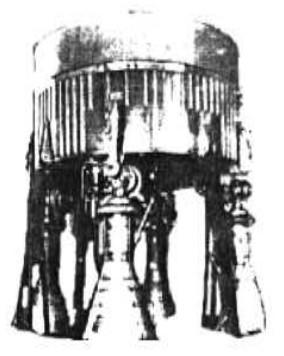
“Cluster of 4 Viking II on Lilo”
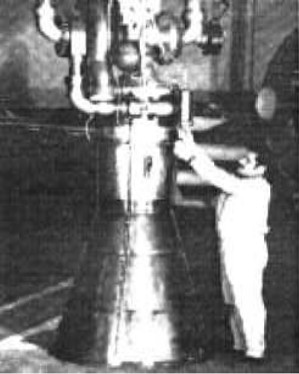
“Comparison between the Viking II and a person”
-Viking engines began to be considered on paper in 1958.
-The following fuels were used on the Viking V: a UH25 mixture consisting of 75% UDMH and 25% hydrazine hydrate.
-As an oxidant, nitrogen peroxide (peroxyde d’azote, in French)

“Cluster of four Viking V” (PeT)
-As we see, the Vikings have been important in the beginning of the Ariane project.
-The chambers of the II had a layer of zirconium and the nozzle was made of graphite. This engine consumed UDMH, that is, “Unsymmetrical dimethyl-hydrazine”.
-The other component was N2O4 or nitrogen tetroxide.
-To realize the proportion of the Viking engines' size, we now provide two photographs, one of a four-engine cluster and the other one with engines in their final construction stage together with technicians whose height they double.

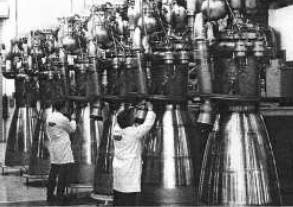
“Viking Engines”
-The Vikings operate with storable fuels such as N2O4 and UDMH, capable of 700 kN of thrust in a vacuum. They were used in European Ariane rockets.
-The different Vikings would reach models I, II, II, IV, V and VI. They were built in collaboration with Volvo and MAN.
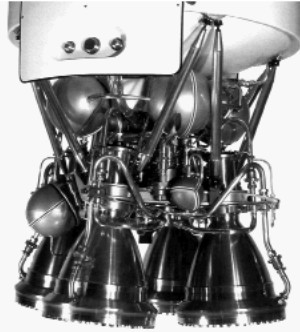
“H2 cluster”
-The H2, H3 and H4 Clusters were mounted on the Diamant A, B and Super-Diamant, (Diogene). The H2 would be the basis for the H4.

“Diamant A and B”
-The H2 clusters were used on the 2nd stage of the Super Diamant, with 6000 DaN (Decanewtons). This was in 1961. It ran on liquid oxygen and hydrogen.
-The H3 is a SEPR heritage too. It was destined for the 3rd stage of the same Diogene.

“H3 cluster”
-The H3, from 1961, gave 400 DaN with a specific impulse of 420 sec.
-Just like the H2 it is fed by turbopumps. The H3 can be fed by pressurizing the tanks with helium for liquid oxygen and with an electric pump for liquid hydrogen.
-It replaced the HM2 for upper stages of launchers. It delivered about 9,000 lbf of thrust.
-The next important engine was the HM7 from 1967, which gave 6100 DaN.
-The turbopump was similar to the one of the HM4. It was used on the third stage of the Ariane 1 to 4 and on the upper stage of the Ariane 5/2. It was reissued in 1972 with 7,000 DaN.

“HM7”
-The HM7 gives about 70 kN of thrust in a vacuum. It uses cryogenic fuel.

“SEP HM7”
-The HM7 has feed pumps that rotate at 60,000 rpm and the nozzle is cooled by the regenerative system.
-MBB participated in the HM7 manufacturing. It uses the same LOX/Liquid Hydrogen fuel, but it gave 15,750 lbf. that is, approximately 7,000 DaN.
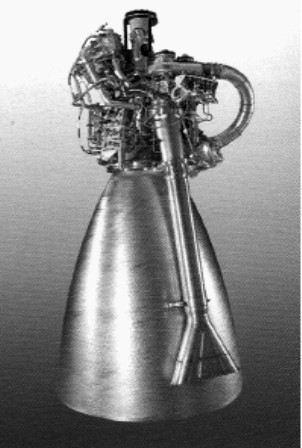
“Another HM7B”
-The Coralie, from LRBA was made since 1961. It is the propulsion stage composed of four engines that gave a power of 27 tons of thrust.
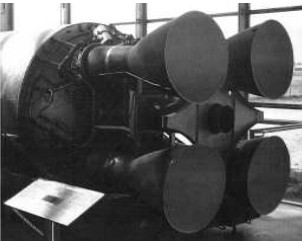
“The Coralie in the Munich Museum”
-It ran on UDMH and Nitrogen Peroxide, it was used in the 2nd stage of the Europa 1, 2 and F7 launchers.
-The SEP P4 was a solid fuel engine that was used on French Navy missiles of the “underwater - to - surface” type. MSBS.

“SEP 4”
-These same MSBS missiles later used the Rita I and II engines. The P4 gave almost 18,000 Kgf of thrust.

“SEP Rita I”
-The Rita I gave 18,000 Kgf of thrust with solid fuel. It also replaced the Topaze engine on the Diamant rocket.
-The 12,245 Kgf Topaze. (UDMH/N2O4).
-Another SEP engine is the “Valois”, which was the Diamant B rocket engine and was rated for 40,000 lbf of thrust at sea level.

“Valois”

“Vexin”
-It came from LRBA (Labotaroire de Recherches Balistiques et Aeronautiques), and it was used on the experimental rockets of the “Precious Stones” group such like the Emeraude and the Saphir.
-It entered service in 1964 and gave power depending on the model, as mentioned below.
-The Vexin A, running on N2O4/UDMH 7000 Kgf for 96 seconds, on the 2nd stage of the Europa. From 1964 to 1971 44 launches were carried out.
-Vexin B for the Diamant A, delivered 7,687 Kgf for 100 seconds and with the same fuel as the Vexin A. It was used between 1965 and 1967.
-The Vexin C delivered 10,000 Kgf for 110 seconds, and it made 36 launches between 1970 and 1975. It was destined for the Diamant B.
-The Astris, coming from SEPR was from 1966, and gave 2,300 DaN for 295 seconds of specific impulse.
-It used Nitrogen Peroxide and Aerozine.
-In the following figure we see only the combustion chamber, lacking the nozzle.
-It was planned for a higher stage (called Astris precisely) of Europe 1. It was done in collaboration with ERNO of Germany.

“Astris Chamber”
-The Ariane V would carry the HM60, a liquid hydrogen and oxygen engine. It was based on the Vulcain engine.
-It gave 800 kN at sea level and 1000 kN in a vacuum. It was built by European cooperation and Snecma's SEP.
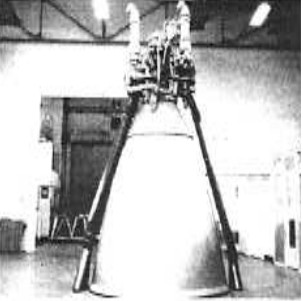
“HM-60”
In 1988, the Vulcain engine began to be studied at SEP for the Ariane 5.
-The “1” used LOX and LH2 and gave 1,140 kN in vacuum condition.
-Today the Vulcain 2 is manufactured by Snecma (see) with 20% more power than the 1.
-Thus, if Vulcain 1 delivered 110,000 Kgf for 605 seconds, Vulcain 2 gave 132,500 Kgf.
-They were tested in Vernon (France) and Lampoldshausen (Germany). See Snecma and Daimler.
-The Ariane 5 EAP has two attached solid fuel rockets, acting as Boosters for takeoff (P-241) that provide 278,330 Kgf of thrust for a weight of 38,200 Kg.
-This thrust was given for about 130 seconds. See Europropulsion.
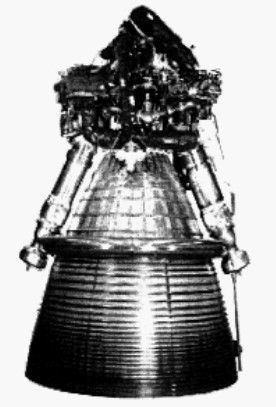
“Vulcain 2”

“Ariane 5 takeoff - flight 503”
-The boosters (MPS) are manufactured 50/50 between Fiat and Snecma. Under the central tank, the Vulcain 2.
-The high-altitude Vinci engine is already a project at Snecma. (See).
-SEP has manufactured a multitude of special engines for weapons such as the one used by the Mistral ammunition from Matra, a SEP ejector motor.

“Matra ammunition with SEP engine”
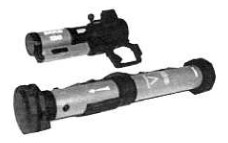
“Dard 120, anti-tank”
-The same for short-range, medium-range, and ballistic missiles. The Halbran (I and II) anti-aircraft are considered low cost.
-This one, the Dard and small rockets use solid fuel, storable, easy to fire, etc.

“Halbran I”
-They continued with atypical rocket-type engines, but with minimal thrust, such as accelerators, maneuvers or “thrusters”.
-The electric type uses cesium ions that are accelerated in a grid, giving a fluid thrust, always very low but with a high specific thrust.
-The cesium from the deposit is vaporized between a concentric cathode and anode, in the presence of a powerful magnetic field.
-The ions are accelerated through a grid and subsequently neutralized by another secondary cathode.
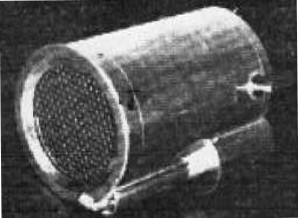
“Ion Thruster”
-They are very long-life engines and can operate, in the case of SEP shown above, for 8 to 10 years.
-Another type of “thruster”, although chemical, are micromotors based on hydrazine as a monopropellant, for satellite control and orbit maintenance.
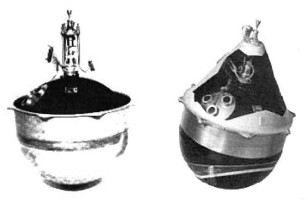
“Two SEP D-5A motors”
-The D-5A, from 1971.
-The thrust, was between 1.8 to 3.4 N (Newtons) for a maximum time of 1,200 seconds (20 minutes).
-We see the engine at the top and a spherical tank for the hydrazine, which previously had to be decomposed using a catalyst.
-The D-5A had the nickname “Pollux” while the D-5B was called “Castor”.
-Another range of engines was the 3.5N and 15N.
-The first one was designed in 1966, and it was considered an orbit altitude control engine.
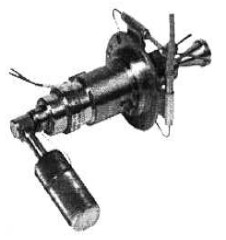
“Thruster 3.5N”
-Depending on the rocket's or missile's mission and due to control or stability requirements, including speed to change transition orbits to circular ones, one engine or another was used.
-Let's say that they are divided into heliosynchronous, geostationary and then they are minisatellites or microsatellites.
-The fuel must be storable. That is the case of hydrazines for satellites that require 1 to 15 N.
-10 to 20 N are necessary for bi-ergoles, as in the case of “20N” shown below.

“SEP 20N” (PiP)
-Other models are the GM.
-They are used on Exosat or Geos satellites (D-5A).
-SEP is located in Villaroche-Nord, next to Snecma.
From Appendix 7: Today at the Safran Group. A charismatic rocket engine has been the Viking, of which several versions were made depending on its use and era.
-Its main application has been in the Ariane 4 launch vehicles.

“Three types of Viking engines”
-Depending on the stage on which they were installed, the nozzle varied in length, the longest being the High Altitude one, that is, in the final stages.

“The different Ariane 4 launch vehicles”
-They are exhibited in several museums, the most visible is at the Snecma de Villaroche museum south of Paris. The last Viking is number 6.
-Below we show a Viking on display.
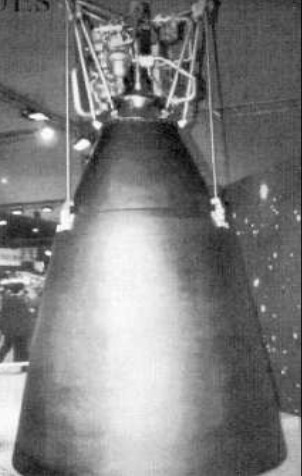
“Viking with high nozzle”
From Appendix 9: SEP has been derived from SEPR, inherited all the models and:
-HM-10
-HM-7A
-HM-7B
-Mage-1 y -2
-P-241
-Rita II
-SEP-401
-SEP-402
-SEP-403
-SEP-901
-SEP-902 (+Sud)
-SEP-903
-SEP-904
-P-167 (+SEPR)
-Topaze
-Vexin-A
-Vexin-B
-Vexin-C

“Viking”
-Viking-2
-Viking-2B
-Viking-4
-Viking-4B
-Viking-5C
-Vulcain
-Vulcain-2
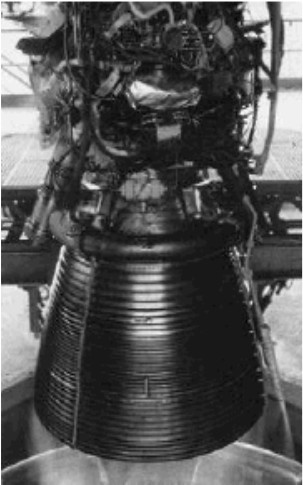
“Vulcain”
Engines of SEP
Model: .P-167 (+Sepr)
Arquitecture:
Chambers:
Fuels:
Feed System:
Ignition:
Thrust:
Weight:
Model: 20-N
Arquitecture:
Chambers:
Fuels:
Feed System:
Ignition:
Thrust:
Weight:
Model: 300, Drac
Arquitecture:
Chambers:
Fuels:
Feed System:
Ignition:
Thrust:
Weight:
Model: 401
Arquitecture:
Chambers:
Fuels:
Feed System:
Ignition:
Thrust:
Weight:
Model: 402
Arquitecture:
Chambers:
Fuels:
Feed System:
Ignition:
Thrust:
Weight:
Model: 403
Arquitecture:
Chambers:
Fuels:
Feed System:
Ignition:
Thrust:
Weight:
Model: 844
Arquitecture:
Chambers:
Fuels:
Feed System:
Ignition:
Thrust:
Weight:
Model: 901
Arquitecture:
Chambers:
Fuels:
Feed System:
Ignition:
Thrust:
Weight:
Model: 902 (+Sud)
Arquitecture:
Chambers:
Fuels:
Feed System:
Ignition:
Thrust:
Weight:
Model: 903
Arquitecture:
Chambers:
Fuels:
Feed System:
Ignition:
Thrust:
Weight:
Model: 904
Arquitecture:
Chambers:
Fuels:
Feed System:
Ignition:
Thrust:
Weight:
Model: Arc
Arquitecture:
Chambers:
Fuels:
Feed System:
Ignition:
Thrust:
Weight:
Model: Astris
Arquitecture:
Chambers:
Fuels:
Feed System:
Ignition:
Thrust:
Weight:
Model: Ball
Arquitecture:
Chambers:
Fuels:
Feed System:
Ignition:
Thrust:
Weight:
Model: Ciron
Arquitecture:
Chambers:
Fuels:
Feed System:
Ignition:
Thrust:
Weight:
Model: Coralie
Arquitecture:
Chambers:
Fuels:
Feed System:
Ignition:
Thrust:
Weight:
Model: D-5A, -B Castor
Arquitecture:
Chambers:
Fuels:
Feed System:
Ignition:
Thrust:
Weight:
Model: Drop
Arquitecture:
Chambers:
Fuels:
Feed System:
Ignition:
Thrust:
Weight:
Model: Eland
Arquitecture:
Chambers:
Fuels:
Feed System:
Ignition:
Thrust:
Weight:
Model: Faon
Arquitecture:
Chambers:
Fuels:
Feed System:
Ignition:
Thrust:
Weight:
Model: GM
Arquitecture:
Chambers:
Fuels:
Feed System:
Ignition:
Thrust:
Weight:
Model: H-2
Arquitecture:
Chambers:
Fuels:
Feed System:
Ignition:
Thrust:
Weight:
Model: H-3
Arquitecture:
Chambers:
Fuels:
Feed System:
Ignition:
Thrust:
Weight:
Model: H-4
Arquitecture:
Chambers:
Fuels:
Feed System:
Ignition:
Thrust:
Weight:
Model: HM-10
Arquitecture:
Chambers:
Fuels:
Feed System:
Ignition:
Thrust:
Weight:
Model: HM-2
Arquitecture:
Chambers:
Fuels:
Feed System:
Ignition:
Thrust:
Weight:
Model: HM-4
Arquitecture:
Chambers:
Fuels:
Feed System:
Ignition:
Thrust:
Weight:
Model: HM-60
Arquitecture:
Chambers:
Fuels:
Feed System:
Ignition:
Thrust:
Weight:
Model: HM-7, -7A, -7B
Arquitecture:
Chambers:
Fuels:
Feed System:
Ignition:
Thrust:
Weight:
Model: Mage-1, -2
Arquitecture:
Chambers:
Fuels:
Feed System:
Ignition:
Thrust:
Weight:
Model: Mars
Arquitecture:
Chambers:
Fuels:
Feed System:
Ignition:
Thrust:
Weight:
Model: P-241
Arquitecture:
Chambers:
Fuels:
Feed System:
Ignition:
Thrust:
Weight:
Model: P-4
Arquitecture:
Chambers:
Fuels:
Feed System:
Ignition:
Thrust:
Weight:
Model: Rita I y II
Arquitecture:
Chambers:
Fuels:
Feed System:
Ignition:
Thrust:
Weight:
Model: Rita, -II
Arquitecture:
Chambers:
Fuels:
Feed System:
Ignition:
Thrust:
Weight:
Model: Sybil
Arquitecture:
Chambers:
Fuels:
Feed System:
Ignition:
Thrust:
Weight:
Model: Topaze
Arquitecture:
Chambers:
Fuels:
Feed System:
Ignition:
Thrust:
Weight:
Model: Trap
Arquitecture:
Chambers:
Fuels:
Feed System:
Ignition:
Thrust:
Weight:
Model: Valois
Arquitecture:
Chambers:
Fuels:
Feed System:
Ignition:
Thrust:
Weight:
Model: Vexin A, B, C
Arquitecture:
Chambers:
Fuels:
Feed System:
Ignition:
Thrust:
Weight:
Model: Viking 2, 2B, 4, 4B, 5C
Arquitecture:
Chambers:
Fuels:
Feed System:
Ignition:
Thrust:
Weight:
Model: Viking I, II, IV, IVB, V, VI
Arquitecture:
Chambers:
Fuels:
Feed System:
Ignition:
Thrust:
Weight:
Model: Vulcain 1
Arquitecture:
Chambers:
Fuels:
Feed System:
Ignition:
Thrust:
Weight:
Model: Vulcain 2
Arquitecture:
Chambers:
Fuels:
Feed System:
Ignition:
Thrust:
Weight:


